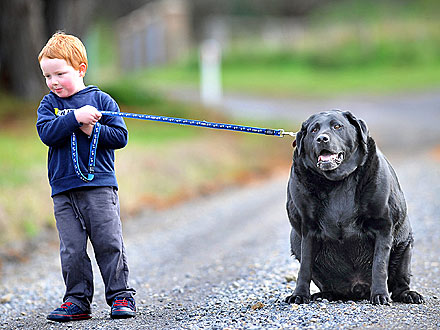| print
link to this post | email a friend The Fat, the Black, the Old, & the Hairy!14 Jun 2017
By Laurie Edge-Hughes, BScPT, MAnimSt (Animal Physio), CAFCI, CCRT
This blog has been inspired by a few different experiences I’ve had lately: Three client stories, and one personal experience. Basically, we four dog owners are concerned about the health of our dogs. Our dogs don’t want to walk. Our dogs are lethargic. Something must be wrong!!! (And since I started writing this, I’ve had this conversation with at least half a dozen more clients who are having similar concerns about their dogs.)
I’ll start with the story of my dog. It’s my rescue Borzoi, Syri. She’s about ten years old, mostly black, and carries a bit of extra ‘padding’ as well. She’s also is a bit of a ‘head case’. She can be weird for all sorts of reasons! Well, one day I decided to take all 4 of my dogs for a walk. It was 9 am, there was a bit of a breeze and it was about 17 degrees C. Perfect, I thought! I could get all of my white dogs enthused about going, but not the black dog. I did manage to get her out of the house, and down to the end of the drive way, but no further. There was no way she was going into the field. I even tried pushing her for a bit! She was standing there shaking like a leaf (and I felt like an ogre)! I gave up and walked her back to the house and the white dogs and I went for a walk. I’ve been noticing that she is a bit more lethargic than normal. She’s fussy about going outside. However, if I wait until 8:30 or 9pm, then she’s like a puppy! Happy, bouncy, yeah-I’ll-go-for-a-walk fool! But during the day, she’s a pancake!
The first of my canine patients is fuzzy, black, well padded, senior dog. Her owner has been noticing that she doesn’t want to walk and isn’t as enthusiastic about eating either. The third dog is a densely-coated (not-black, she’s tan) dog and the owners are noticing she’s not so interested in going for walks. On questioning, the 4pm walk in particular. And the last dog was a small senior dog, and the owners have been finding him to simply be more lethargic than usual and he pants more too.
Naturally, we’re all freaking out a little bit! Our brains go to the worst-case scenario right off the bat. What if it C…? And while that is always a possibility, perhaps we should think about all of the factors. Slow down a bit, and just be rational.
1. My black dog heats up like a frying pan when she’s out in full sun! She will ‘hold her urine’ ALL DAY and not go outside other than first thing in the morning and then right after dinner in the evening in the Spring / Summer. When she does go out into full sun, it takes just a few minutes before her hair coat is hot. Not just warm, but hot! Conversely, even if the temperature is in the 20’s but overcast or late enough in the day that the angle of the sun is different, then she’s fine with going outside! 2.Dogs (and people) that carry extra weight tend to be warmer, especially in warmer weather. Fat = insulation, and too much insulation on a hot day is like wearing your snowsuit to the beach! Dogs likely have it worse than people, because they don’t sweat. They have to pant to cool down. 3.A thick coat of hair may then have the same impact as excess weight. It may act as an insulator for some dogs, making them heat up faster and then have difficulties dispersing the heat. 4.Lastly, age can play a factor. There are some reports in human literature that humans (45 +) may suffer more physiological strain during heat acclimatization than younger individuals. This may be related to aerobic fitness, levels of dehydration in the older individuals, and environmental humidity.
So, what should we take from this? There are a few things you could try. Firstly, try going for your daily walk(s) either early or late in the day, when the sun is low. Secondly, you may need to reduce your dog’s body weight (and we can help with our Fluffy to Fit program). Thirdly, keep your dog well brushed out to remove dead hair, contemplate a ‘summer haircut / trim’, use a ‘cooling jacket’ (they are wetted and have gel beads that can keep the dog cool when it’s on), or spritz your dog with cold water (the ‘mist setting’ on your garden nozzle) before heading out to walk might combat the heat issues. Fourthly, the age of your dog may be a factor, so perhaps you could do some indoor exercises with your dog in your basement instead, or bring him / her in for an underwater treadmill session as a different means of exercise. And I’m going to add in a fifth thought as my finale, maybe you need to encourage your pooch to drink a bit more fluids. Low sodium (or home-made) broth could be provided or added to food to increase water / fluid consumption.
You likely want to try a combination of these suggestions and see how your dog responds. And naturally, if you still have concerns or see other unusual or troubling signs in your pet, it’s best to book an appointment with your vet!
|

|

